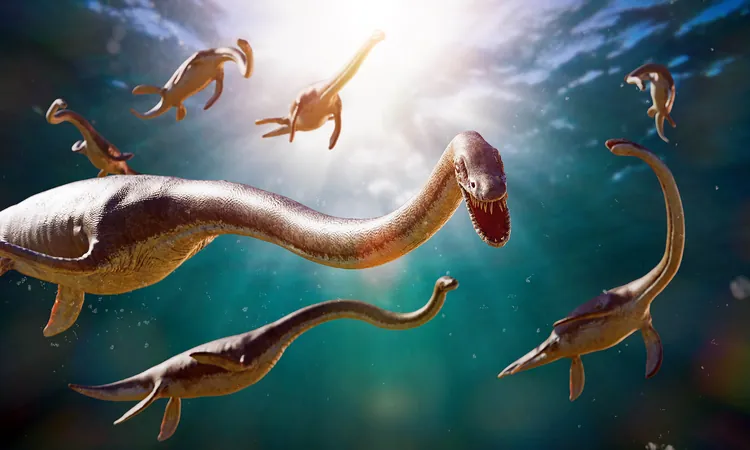
Prehistoric Ocean Giants: The Fearsome Predators that Feasted on Killer Whales!
2025-01-18
Author: Ting
Did you know that ancient marine reptiles lurking in the waters of what is now central Colombia could have gobbled up today’s formidable killer whales for breakfast? Recent research has unveiled thrilling insights into these prehistoric giants and their dominance in ancient ocean ecosystems.
Paleontologists have uncovered evidence showing that these ancient reptilian predators flourished around 130 million years ago, swimming through waters that befitted their extraordinary size and power. Some of these behemoths could stretch over 33 feet (10 meters), positioning them as apex predators within their ecosystems—resulting in mysterious implications about the evolution of modern ocean environments.
The Apex of the Ancient Food Chain
Unlike today’s killer whales and great white sharks, which hover around the sixth trophic level in the ocean's food hierarchy, these ancient marine reptiles claimed dominance at the seventh level. This discovery raises fascinating questions about the complexity and development of marine food webs over millions of years.
Lead researcher Dirley Cortés from McGill University’s Department of Biology, alongside co-author Hans Larsson, highlighted how their findings mark a significant leap in understanding prehistoric ecological interactions. “Our study is the first to examine these possible ecological interactions,” Cortés explains.
Reimagining Life Below the Waves
By investigating fossil evidence from the Paja Formation, scientists pieced together a lost food web steeped in intrigue. The vibrant marine life of the Early Cretaceous was flourishing, thanks to warm climates that promoted unprecedented ocean diversity. The robust jaws and swift movements of these reptiles were suggestive of fierce hunting techniques that propelled them to the top of their food chain.
Utilizing comparisons to modern-day Caribbean reef ecosystems, the team showed intricate connections among prehistoric marine animals that stretched the boundaries of conventional marine hierarchies. This knowledge is crucial for understanding not just the past, but how such ecosystems adapt and thrive—or fail—in the face of modern challenges like climate change.
The Evolutionary Arms Race
The dynamics of marine competition greatly influenced the evolution of these ancient eaters. The Mesozoic era witnessed a surge in predatory invertebrates like shell-crushing snails, a phenomenon paleontologists term the Mesozoic Marine Revolution. In this environment, ancient marine reptiles developed giant sizes and rigorous hunting strategies, paving the way for diverse evolutionary paths in marine life.
Cortés pointed out that these findings illuminate how marine ecosystems evolved through fierce trophic competition, influencing the variety of species we observe today. This stark reminder of life's adaptability carries an important message: the oceans have experienced revolutionary biodiversity changes long before humanity arrived on the scene.
What This Means for Today's Ecosystems
Studying these ancient oceanic giants does more than satisfy scientific curiosity; it provides valuable lessons for contemporary ecosystems. Insights gained from ancient predator-prey relationships reveal how species at the food chain's pinnacle can drastically reshape their environments, paving the way for new forms of life and enhancing biodiversity.
Moreover, researchers aim to explore other fossil sites to ascertain whether these extraordinary seventh-level predators were unique or if other similar ecosystems existed in Earth’s history. The potential to uncover additional sites housing such formidable hunters could reshape our understanding of marine evolution.
A Deep Dive into Earth’s Past
As we continue to uncover the mysteries of ancient marine ecosystems, it’s clear that the oceans were once home to creatures even more fearsome than what we know today. Each revelation from fossil records—from specialized teeth to powerful jaws—adds essential pieces to the puzzle of Earth's maritime evolution.
As researchers peer into the deep past, they pave the way for a greater understanding of how life on Earth has withstood the test of time and adapted to changes in its environment, reminding us of the ever-shifting dance of existence—past and present.
Stay tuned for more riveting discoveries that promise to reshape the picture of life in our oceans!
*This study has been published in the Zoological Journal of the Linnean Society.*



 Brasil (PT)
Brasil (PT)
 Canada (EN)
Canada (EN)
 Chile (ES)
Chile (ES)
 Česko (CS)
Česko (CS)
 대한민국 (KO)
대한민국 (KO)
 España (ES)
España (ES)
 France (FR)
France (FR)
 Hong Kong (EN)
Hong Kong (EN)
 Italia (IT)
Italia (IT)
 日本 (JA)
日本 (JA)
 Magyarország (HU)
Magyarország (HU)
 Norge (NO)
Norge (NO)
 Polska (PL)
Polska (PL)
 Schweiz (DE)
Schweiz (DE)
 Singapore (EN)
Singapore (EN)
 Sverige (SV)
Sverige (SV)
 Suomi (FI)
Suomi (FI)
 Türkiye (TR)
Türkiye (TR)
 الإمارات العربية المتحدة (AR)
الإمارات العربية المتحدة (AR)